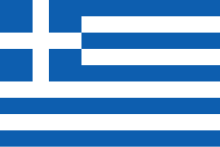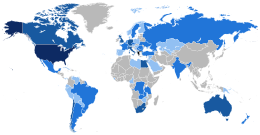ชาวกรีก
ชาวกรีก (กรีก: Έλληνες) เป็นกลุ่มชาติพันธุ์ที่มีการกระจายในกรีซ, ไซปรัส, แอลเบเนีย, อิตาลี และอีกหลายภูมิภาคทั่วโลก[44]
 | |
| ประชากรทั้งหมด | |
|---|---|
ป. 14–17 ล้านคน[1][2]
 | |
| ภูมิภาคที่มีประชากรอย่างมีนัยสำคัญ | |
| ชาวกรีกพลัดถิ่น | |
| 1,279,000–3,000,000[5][6] | |
| 721,000[7][8][9] | |
| 443,000[10] | |
| 422,234[11] | |
| 345,000–400,000[12] | |
| 271,405[13] | |
| 215,000[14] | |
| 200,000[15][16][17] | |
| 138,000[18] | |
| 110,000[19][20] | |
| 100,000[21] | |
| 91,000[22] | |
| 85,640[23] | |
| 50,000[24] | |
| ป. 50,000 [25] | |
| 50,000[26][27] | |
| 35,000[28] | |
| 35,000[29] | |
| 30,000[30] | |
| 28,500[31][32] | |
| 25,709[33] | |
| 25,000[34] | |
| 24,736[35] | |
| 15,000[36] | |
| 12,000[37] | |
| 12,000[38] | |
| 11,000[39] | |
| 10,000[40] | |
| 9,500[41] | |
| 5,261[42] | |
| 4,454[43] | |
| ภาษา | |
| กรีก | |
| ศาสนา | |
| ส่วนมาก: คริสต์นิกายกรีกออร์ทอดอกซ์ | |
อ้างอิง
แก้- ↑ Maratou-Alipranti 2013, p. 196: "The Greek diaspora remains large, consisting of up to 4 million people globally."
- ↑ Clogg 2013, p. 228: "Greeks of the diaspora, settled in some 141 countries, were held to number 7 million although it is not clear how this figure was arrived at or what criteria were used to define Greek ethnicity, while the population of the homeland, according to the 1991 census, amounted to some 10.25 million."
- ↑ "2011 Population and Housing Census". Hellenic Statistical Authority. 12 September 2014. คลังข้อมูลเก่าเก็บจากแหล่งเดิมเมื่อ 16 July 2016. สืบค้นเมื่อ 18 May 2016.
The Resident Population of Greece is 10.816.286, of which 5.303.223 male (49,0%) and 5.513.063 female (51,0%) ... The total number of permanent residents of Greece with foreign citizenship during the Census was 912.000. [See Graph 6: Resident Population by Citizenship]
- ↑ "Statistical Data on Immigrants in Greece: An Analytic Study of Available Data and Recommendations for Conformity with European Union Standards" (PDF). Archive of European Integration (AEI). University of Pittsburgh. 15 November 2004. สืบค้นเมื่อ 18 May 2016.
[p. 5] The Census recorded 762.191 persons normally resident in Greece and without Greek citizenship, constituting around 7% of total population. Of these, 48.560 are EU or EFTA nationals; there are also 17.426 Cypriots with privileged status.
- ↑ "Total ancestry categories tallied for people with one or more ancestry categories reported 2011–2013 American Community Survey 3-Year Estimates". American FactFinder. U.S. Department of Commerce: United States Census Bureau. 2013. คลังข้อมูลเก่าเก็บจากแหล่งเดิมเมื่อ 14 February 2020. สืบค้นเมื่อ 23 May 2016.
- ↑ "U.S. Relations with Greece". United States Department of State. 10 March 2016. สืบค้นเมื่อ 18 May 2016.
Today, an estimated three million Americans resident in the United States claim Greek descent. This large, well-organized community cultivates close political and cultural ties with Greece.
- ↑ Statistical Service (2003–2016). "Preliminary Results of the Census of Population, 2011". Republic of Cyprus, Ministry of Finance, Statistical Service. คลังข้อมูลเก่าเก็บจากแหล่งเดิมเมื่อ 2013-01-15. สืบค้นเมื่อ 2021-04-21.
- ↑ Cole 2011, Yiannis Papadakis, "Cypriots, Greek", pp. 92–95
- ↑ "Where are the Greek communities of the world?". themanews.com. Protothemanews.com. 2013. คลังข้อมูลเก่าเก็บจากแหล่งเดิมเมื่อ 4 March 2016. สืบค้นเมื่อ 14 August 2015.
- ↑ "Statistical Yearbook Germany Extract Chapter 2: Population, Families and Living Arrangements in Germany". Statistisches Bundesamt. 14 March 2013. p. 21.
- ↑ "2071.0 – Reflecting a Nation: Stories from the 2011 Census, 2012–2013". Australian Bureau of Statistics. 21 June 2012. สืบค้นเมื่อ 13 February 2014.
- ↑ "United Kingdom: Cultural Relations and Greek Community". Hellenic Republic: Ministry of Foreign Affairs. 9 July 2013.
There are between 40 and 45 thousand Greeks residing permanently in the UK, and the Greek Orthodox Church has a strong presence in the Archdiocese of Thyateira and Great Britain ... There is a significant Greek presence of Greek students in tertiary education in the UK. A large Cypriot community – numbering 250–300 thousand – rallies round the National Federation of Cypriots in Great Britain and the Association of Greek Orthodox Communities of Great Britain.
- ↑ "Immigration and Ethnocultural Diversity Highlight Tables". statcan.gc.ca.
- ↑ Jeffries 2002, p. 69: "It is difficult to know how many ethnic Greeks there are in Albania. The Greek government, it is typically claimed, says there are around 300,000 ethnic Greeks in Albania, but most Western estimates are around the 200,000 mark ..."
- ↑ "Italy: Cultural Relations and Greek Community". Hellenic Republic: Ministry of Foreign Affairs. 9 July 2013.
The Greek Italian community numbers some 30,000 and is concentrated mainly in central Italy. The age-old presence in Italy of Italians of Greek descent – dating back to Byzantine and Classical times – is attested to by the Griko dialect, which is still spoken in the Magna Graecia region. This historically Greek-speaking villages are Condofuri, Galliciano, Roccaforte del Greco, Roghudi, Bova and Bova Marina, which are in the Calabria region (the capital of which is Reggio). The Grecanic region, including Reggio, has a population of some 200,000, while speakers of the Griko dialect number fewer that 1,000 persons.
- ↑ "Grecia Salentina" (ภาษาอิตาลี). Unione dei Comuni della Grecìa Salentina. 2016. คลังข้อมูลเก่าเก็บจากแหล่งเดิมเมื่อ 2014-08-19. สืบค้นเมื่อ 2021-04-21.
La popolazione complessiva dell'Unione è di 54278 residenti così distribuiti (Dati Istat al 31° dicembre 2005. Comune Popolazione Calimera 7351 Carpignano Salentino 3868 Castrignano dei Greci 4164 Corigliano d'Otranto 5762 Cutrofiano 9250 Martano 9588 Martignano 1784 Melpignano 2234 Soleto 5551 Sternatia 2583 Zollino 2143 Totale 54278).
- ↑ Bellinello 1998, p. 53: "Le attuali colonie Greche calabresi; La Grecìa calabrese si inscrive nel massiccio aspromontano e si concentra nell'ampia e frastagliata valle dell'Amendolea e nelle balze più a oriente, dove sorgono le fiumare dette di S. Pasquale, di Palizzi e Sidèroni e che costituiscono la Bovesia vera e propria. Compresa nei territori di cinque comuni (Bova Superiore, Bova Marina, Roccaforte del Greco, Roghudi, Condofuri), la Grecia si estende per circa 233 km (145 mi)q. La popolazione anagrafica complessiva è di circa 14.000 unità."
- ↑ "South Africa: Cultural Relations and Greek Community". Hellenic Republic: Ministry of Foreign Affairs. 4 February 2011. คลังข้อมูลเก่าเก็บจากแหล่งเดิมเมื่อ 19 June 2006.
- ↑ "English version of Greek Ministry of Foreign Affairs reports a few thousand and Greek version 3.800". MFA.gr.
- ↑ Rippin, Andrew (2008). World Islam: Critical Concepts in Islamic Studies. Routledge. p. 77. ISBN 978-0415456531.
- ↑ Parvex R. (2014). Le Chili et les mouvements migratoires, Hommes & migrations, Nº 1305, 2014. doi: 10.4000/hommesmigrations.2720.
- ↑ "Ukraine: Cultural Relations and Greek Community". Hellenic Republic: Ministry of Foreign Affairs. 4 February 2011.
There is a significant Greek presence in southern and eastern Ukraine, which can be traced back to ancient Greek and Byzantine settlers. Ukrainian citizens of Greek descent amount to 91,000 people, although their number is estimated to be much higher by the Federation of Greek communities of Mariupol.
- ↑ "Итоги Всероссийской переписи населения 2010 года в отношении демографических и социально-экономических характеристик отдельных национальностей". คลังข้อมูลเก่าเก็บจากแหล่งเดิมเมื่อ 2021-12-09. สืบค้นเมื่อ 2021-04-21.
- ↑ "The Greek Community". คลังข้อมูลเก่าเก็บจากแหล่งเดิมเมื่อ 13 June 2007.
- ↑ "Greeks Around the Globe". AusGreekNet. คลังข้อมูลเก่าเก็บจากแหล่งเดิมเมื่อ 19 June 2006.
- ↑ "World Directory of Minorities and Indigenous Peoples – Turkey: Rum Orthodox Christians". Minority Rights Group (MRG). 2005. คลังข้อมูลเก่าเก็บจากแหล่งเดิมเมื่อ 29 March 2014. สืบค้นเมื่อ 1 March 2014.
- ↑ "Pontic". Ethnologue: Languages of the World. SIL International. 2016. สืบค้นเมื่อ 13 May 2016.
- ↑ "France: Cultural Relations and Greek Community". Hellenic Republic: Ministry of Foreign Affairs. 9 July 2013.
Some 15,000 Greeks reside in the wider region of Paris, Lille and Lyon. In the region of Southern France, the Greek community numbers some 20,000.
- ↑ "Belgium: Cultural Relations and Greek Community". Hellenic Republic: Ministry of Foreign Affairs. 28 January 2011.
Some 35,000 Greeks reside in Belgium. Official Belgian data numbers Greeks in the country at 17,000, but does not take into account Greeks who have taken Belgian citizenship or work for international organizations and enterprises.
- ↑ "Argentina: Cultural Relations and Greek Community". Hellenic Republic: Ministry of Foreign Affairs. 9 July 2013.
It is estimated that some 20,000 to 30,000 persons of Greek origin currently reside in Argentina, and there are Greek communities in the wider region of Buenos Aires.
- ↑ "Население по местоживеене, възраст и етническа група". censusresults.nsi.bg. สืบค้นเมื่อ 2020-10-15.
- ↑ "Bulgaria: Cultural Relations and Greek Community". Hellenic Republic: Ministry of Foreign Affairs. 28 January 2011.
There are some 28,500 persons of Greek origin and citizenship residing in Bulgaria. This number includes approximately 15,000 Sarakatsani, 2,500 former political refugees, 8,000 "old Greeks", 2,000 university students and 1,000 professionals and their families.
- ↑ "CBS Statline".
- ↑ "Immigration to Uruguay" (PDF) (ภาษาสเปน). INE. คลังข้อมูลเก่าเก็บจากแหล่งเดิม (PDF)เมื่อ 16 August 2013. สืบค้นเมื่อ 6 March 2013.
- ↑ "Sweden: Cultural Relations and Greek Community". Hellenic Republic: Ministry of Foreign Affairs. 4 February 2011.
The Greek community in Sweden consists of approximately 24,000 Greeks who are permanent inhabitants, included in Swedish society and active in various sectors: science, arts, literature, culture, media, education, business, and politics.
- ↑ "Georgia: Cultural Relations and Greek Community". Hellenic Republic: Ministry of Foreign Affairs. 31 January 2011.
The Greek community of Georgia is currently estimated at 15,000 people, mostly elderly people living in the Tsalkas area.
- ↑ "Migranti z Řecka v Česku" [Migrants from Greece in the Czech Republic] (PDF). Hellenic Republic: Ministry of Foreign Affairs (ภาษาเช็ก). 9 March 2011. คลังข้อมูลเก่าเก็บจากแหล่งเดิม (PDF)เมื่อ 2022-10-09. สืบค้นเมื่อ 25 April 2019.
- ↑ "Kazakhstan: Cultural Relations and Greek Community". Hellenic Republic: Ministry of Foreign Affairs. 3 February 2011.
There are between 10,000 and 12,000 ethnic Greeks living in Kazakhstan, organized in several communities.
- ↑ "Switzerland: Cultural Relations and Greek Community". Hellenic Republic: Ministry of Foreign Affairs. 10 December 2015.
The Greek community in Switzerland is estimated to number some 11,000 persons (of a total of 1.5 million foreigners residing in the country.
- ↑ "Romania: Cultural Relations and Greek Community". Hellenic Republic: Ministry of Foreign Affairs. 6 December 2013.
The Greek Romanian community numbers some 10,000, and there are many Greeks working in established Greek enterprises in Romania.
- ↑ "Greeks in Uzbekistan". Central Asia-Caucasus Analyst. The Central Asia-Caucasus Institute. 21 June 2000.
Currently there are about 9,500 Greeks living in Uzbekistan, with 6,500 living in Tashkent.
- ↑ Bevölkerung nach Staatsangehörigkeit und Geburtsland
- ↑ Vukovich, Gabriella (2018). Mikrocenzus 2016 – 12. Nemzetiségi adatok [2016 microcensus – 12. Ethnic data] (PDF). Hungarian Central Statistical Office (ภาษาฮังการี). Budapest. ISBN 978-963-235-542-9. สืบค้นเมื่อ 9 January 2019.
- ↑ Roberts 2007, pp. 171–172, 222.